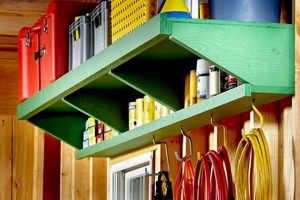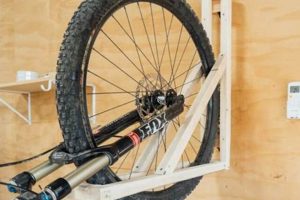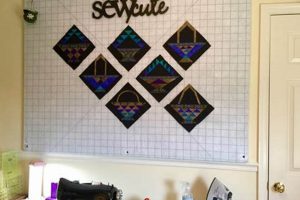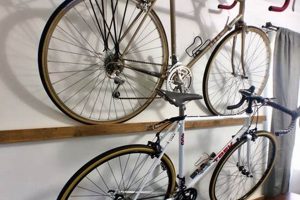A ready-to-assemble package providing the necessary components and instructions for constructing a bed that can be folded vertically or horizontally against a wall. These sets typically include the mechanical hardware, such as pistons or spring mechanisms, and detailed guides, allowing individuals to create a space-saving sleeping solution. For instance, a small apartment dweller might utilize this to convert a living area into a bedroom at night and back again during the day.
The rise in popularity stems from the increasing need for efficient space utilization, particularly in urban environments where living areas are often compact. Benefits include maximizing floor space, creating multi-functional rooms, and offering a cost-effective alternative to purchasing larger properties. Historically, variations of fold-away beds have been employed to address space constraints, evolving from simple hinged designs to more sophisticated systems with counterbalancing mechanisms.
The subsequent discussion will delve into the selection criteria for choosing a suitable product, the crucial aspects of the assembly process, safety considerations during installation and operation, and the long-term maintenance requirements to ensure the continued functionality and longevity of such space-saving furniture.
Essential Considerations for Self-Assembly Projects
Successful implementation requires meticulous planning and careful execution. The following guidance ensures optimal results and minimizes potential complications.
Tip 1: Comprehensive Inventory. Prior to commencing assembly, meticulously verify that all components listed in the instruction manual are present and undamaged. Discrepancies should be addressed with the supplier before proceeding.
Tip 2: Adherence to Instructions. Strictly follow the manufacturers assembly instructions. Deviation may compromise the structural integrity and functionality of the unit. Consult supplementary resources if the provided documentation is unclear.
Tip 3: Structural Integrity Assessment. Evaluate the wall’s load-bearing capacity prior to installation. Confirm that the wall is capable of supporting the weight of the assembled unit, including the mattress and any additional load.
Tip 4: Precise Measurement and Alignment. Accurate measurement and precise alignment are crucial for smooth operation. Employ a level and measuring tape to ensure proper positioning of all components.
Tip 5: Hardware Fastening. Secure all hardware components according to the specified torque requirements. Over-tightening or under-tightening fasteners can compromise stability.
Tip 6: Functional Testing. Upon completion, thoroughly test the folding mechanism to ensure smooth and secure operation. Verify that the locking mechanisms engage properly.
Tip 7: Safety Protocol Adherence. Observe all safety precautions outlined in the instruction manual. Utilize appropriate personal protective equipment, such as safety glasses and gloves, during assembly.
These key points emphasize the importance of preparedness, precision, and safety consciousness. Adhering to these principles will contribute to a successful assembly process and a long-lasting, functional space-saving solution.
The subsequent section will address common troubleshooting scenarios encountered during installation and offer practical solutions to resolve these issues effectively.
1. Mechanism Reliability
The operational integrity of a self-assembly fold-away bed hinges critically on the dependability of its mechanical components. A compromised mechanism negates the space-saving benefits and introduces potential safety hazards. Consequently, a rigorous evaluation of mechanical reliability is paramount before procurement and during assembly.
- Spring and Piston Integrity
Gas springs or piston mechanisms counterbalance the weight of the bed frame and mattress, facilitating smooth raising and lowering. Defective or under-rated springs can lead to abrupt deployments or difficulty in maneuvering the bed. Examples include models with improperly calibrated gas struts failing after limited use, rendering the bed unusable. The implication for the end-user is a potential for injury and the need for costly replacements.
- Hinge and Joint Durability
Hinges and joints are load-bearing points subject to constant stress from repeated folding and unfolding. Substandard materials or poor design can result in premature wear, loosening, or complete failure. An example is the use of thin-gauge steel in hinges that subsequently bend or break under the weight of a queen-sized mattress. This diminishes stability and can lead to structural collapse, especially if the bed is frequently used.
- Locking System Security
A reliable locking system prevents unintended opening, particularly crucial when the bed is stowed in the upright position. Inferior latch designs or weak locking mechanisms can fail, allowing the bed to fall open unexpectedly. A home with children may face increased risk should the locking mechanism disengage without warning, leading to potential accidents.
- Frame Support and Alignment
The underlying frame must maintain structural integrity to ensure the mechanism operates smoothly and safely. Warping or misalignment can create excessive stress on the mechanical components, accelerating wear and tear. A common issue arises when particleboard frames, inadequately reinforced, begin to sag over time, impeding the bed’s ability to retract fully and causing undue strain on the hinges and springs.
In summation, each facet of mechanical reliability plays an integral role in the overall performance and safety of a DIY fold-away bed. A failure in any one area can compromise the entire structure, underscoring the necessity of sourcing high-quality components and adhering strictly to assembly guidelines. Further examples might include comparing different types of mechanisms, such as spring-based versus piston-based, and their respective advantages and disadvantages in terms of long-term reliability.
2. Space Optimization
The core function of a self-assembly fold-away bed resides in its capacity to optimize spatial arrangements. This attribute directly addresses the limitations imposed by confined living areas, particularly in urban settings where square footage commands a premium. The cause-and-effect relationship is straightforward: reduced floor space necessitates innovative storage solutions, and these solutions are directly provided through the implementation of such designs. Space optimization, therefore, is not merely a desirable feature; it constitutes a fundamental component. For instance, in micro-apartments, a living room can transition into a bedroom within moments, effectively doubling the utility of the area without requiring structural alterations. The practical significance of this attribute resides in the increased efficiency and adaptability of living spaces, allowing for a greater range of activities within the same physical footprint.
Further analysis reveals that effective space optimization relies on careful design and execution. The wall bed must be unobtrusive when stowed, minimizing protrusion into the room and integrating seamlessly with the existing decor. Examples include fold-away beds concealed within custom-built cabinetry, transforming into shelving units or desks when not in use. Additionally, the integration of storage compartments within the bed frame itself, such as drawers or shelving, contributes to further optimizing the available space. The design must consider ease of access and usability, ensuring that the transition between configurations is effortless and does not compromise functionality. In practical application, this might involve incorporating a lightweight mattress that is easy to handle or utilizing a counterbalancing mechanism that requires minimal effort to operate.
In conclusion, space optimization is an inherent and indispensable attribute, offering a practical solution to the challenges posed by limited living areas. Success relies on thoughtful design, careful assembly, and the integration of supplementary features that enhance functionality. While the assembly process presents challenges, the resultant gain in usable space and adaptability underscores the value. This spatial utility links to the broader theme of efficient living, allowing for greater flexibility and resourcefulness in the design and use of domestic environments.
3. Material Durability
The longevity and operational safety of a self-assembly fold-away bed are intrinsically linked to the robustness of the materials employed in its construction. Material durability directly influences the unit’s ability to withstand the stresses of repeated use, resist environmental degradation, and maintain structural integrity over time. A compromised material foundation will invariably lead to premature failure, rendering the space-saving benefits null and introducing potential safety hazards.
- Frame Material Selection
The primary frame material dictates the overall load-bearing capacity and resistance to warping or deformation. Options range from solid hardwoods and engineered wood products to steel framing. For instance, a frame constructed from particleboard may exhibit lower resistance to moisture and may be more prone to sagging under prolonged load compared to a solid wood or steel counterpart. The implications include reduced stability and potential for mechanical failure, impacting the bed’s operational lifespan.
- Hardware Composition
Hinges, brackets, and fasteners are crucial for secure assembly and smooth operation. The composition of these components, often steel or aluminum alloys, determines their resistance to corrosion, fatigue, and stress fracturing. Inferior hardware may exhibit premature wear, leading to loosening or breakage, which compromises the unit’s stability. A real-world scenario involves hinges constructed from low-grade steel corroding rapidly in humid environments, causing the bed to become difficult to operate and potentially unsafe.
- Finish and Surface Treatment
The applied finish or surface treatment not only enhances the aesthetic appeal but also protects the underlying material from environmental factors such as moisture, UV radiation, and abrasion. A durable finish, such as powder coating or a multi-layer lacquer, can significantly extend the lifespan of the unit by preventing rust, fading, and scratches. Conversely, a poorly applied or inadequate finish may fail to provide sufficient protection, leading to accelerated degradation and requiring costly repairs or replacements.
- Mattress Support System
The material composition of the mattress support system, typically slats or a platform, influences the comfort and longevity of the mattress itself. The support system must be capable of distributing weight evenly and resisting sagging or deformation over time. For instance, slats constructed from flexible wood, such as plywood, offer improved weight distribution compared to rigid boards, which can create pressure points and accelerate mattress wear. The proper material choice optimizes comfort and contributes to the overall durability of the sleep system.
In conclusion, material durability is a critical determinant of the long-term performance and safety of a self-assembly fold-away bed. The selection of appropriate materials for the frame, hardware, finish, and mattress support system directly impacts the unit’s ability to withstand the rigors of daily use and resist environmental degradation. Neglecting this fundamental aspect can result in premature failure, increased maintenance costs, and potential safety hazards, undermining the intended benefits of space optimization.
4. Assembly Complexity
The assembly complexity associated with a self-assembly fold-away bed directly influences its accessibility to a broad consumer base and the ultimate success of the project. The correlation between the intricacy of the assembly process and the potential for error is undeniable; increased complexity elevates the risk of misinterpretation of instructions, incorrect component installation, and subsequent structural instability. The significance of understanding assembly complexity resides in the need for realistic assessment of one’s skills and capabilities relative to the demands of the specific product. A high level of complexity may necessitate professional assistance, negating the cost-saving advantage of a self-assembly approach. For example, a kit requiring advanced carpentry skills, specialized tools, and precise measurements poses a significant challenge for individuals with limited experience in such tasks.
Further consideration reveals that assembly complexity is not solely determined by the number of components or steps involved. The clarity and completeness of the instruction manual, the design’s inherent tolerance for minor errors, and the availability of technical support all contribute significantly. A well-designed kit will incorporate intuitive assembly processes, clearly labeled components, and comprehensive documentation with visual aids. Conversely, a poorly designed kit may feature ambiguous instructions, poorly machined parts, and a lack of accessible customer support. This can result in frustration, delays, and, in some cases, a structurally unsound final product. The practical application of this understanding involves carefully reviewing customer feedback, assessing the manufacturer’s documentation, and considering one’s own skill set before committing to a particular self-assembly project. If an individual lacks confidence in their ability to accurately interpret blueprints or operate power tools, engaging a professional installer is advisable.
In summary, assembly complexity represents a pivotal factor influencing the successful implementation of a DIY fold-away bed project. While the prospect of assembling such a space-saving solution is appealing, a realistic assessment of the task’s demands is crucial. Challenges stem from unclear instructions, intricate designs, and the need for specialized tools. Addressing these challenges necessitates a comprehensive evaluation of one’s own skill level and a willingness to seek professional assistance when necessary. The broader theme revolves around balancing the desire for cost savings and customization with the pragmatic realities of construction complexity and the paramount importance of safety and structural integrity.
5. Safety Features
The inherent design of a self-assembly fold-away bed necessitates a critical emphasis on integrated safety features. The potential energy stored within the folding mechanism, combined with the significant mass of the bed frame and mattress, presents substantial risk of injury if appropriate safeguards are absent. The direct consequence of inadequate safety provisions is an elevated probability of accidental deployment, collapse, or entrapment. The incorporation of robust safety features is not merely an optional addendum; it represents a fundamental design requirement. An illustrative case involves a bed lacking a secure locking mechanism, resulting in unintended deployment and causing physical harm to an individual situated nearby. The practical significance lies in the demonstrable need for proactive safety measures to mitigate foreseeable hazards.
Further examination reveals that effective safety features encompass a range of design elements and operational protocols. A reliable locking mechanism, capable of securely retaining the bed in the stowed position, is paramount. Additionally, a controlled deployment system, often utilizing dampened gas springs or counterbalanced mechanisms, mitigates the risk of sudden, uncontrolled descent. Real-world instances highlight the importance of clearly labeled weight limitations and operational instructions. For example, exceeding the specified weight capacity may overload the support system, leading to structural failure. Similarly, failing to adhere to proper operating procedures can compromise the locking mechanism and increase the likelihood of accidental deployment. Adherence to established safety standards, such as those promulgated by relevant regulatory bodies, provides a framework for ensuring minimum acceptable levels of safety. The practical application of this knowledge involves meticulous inspection of the locking and deployment systems, adherence to weight restrictions, and regular maintenance to ensure continued functionality.
In conclusion, integrated safety features are indispensable components of a self-assembly fold-away bed, directly impacting user well-being and minimizing the potential for accidents. Challenges arise in ensuring that safety mechanisms are robust, user-friendly, and consistently maintained. This necessitates a commitment to rigorous quality control during manufacturing, clear and accessible operating instructions, and proactive maintenance by the end-user. The underlying theme emphasizes the ethical responsibility of manufacturers to prioritize safety and the corresponding need for informed consumers to demand and verify adequate safeguards before purchase and during operation.
Frequently Asked Questions
This section addresses common inquiries regarding self-assembly fold-away beds, providing factual information to assist in informed decision-making.
Question 1: What structural wall type is required for installation?
Installation mandates a load-bearing wall capable of supporting the unit’s weight, including the mattress and bedding. Concrete, reinforced masonry, or adequately framed stud walls are typically suitable. Drywall alone is insufficient and requires secure attachment to underlying structural members.
Question 2: Is specialized carpentry experience necessary for assembly?
While prior carpentry experience is beneficial, it is not always essential. Adherence to the manufacturer’s instructions is paramount. Projects with complex designs or intricate mechanisms may necessitate professional assistance.
Question 3: What tools are typically required for assembly?
Standard tools commonly include a power drill, screwdriver set, level, measuring tape, stud finder, and safety glasses. Some kits may require specialized tools, such as a torque wrench, which will be specified in the documentation.
Question 4: What is the typical weight capacity of a self-assembly fold-away bed?
Weight capacity varies depending on the specific model and construction materials. Manufacturers typically specify a maximum weight limit in the product specifications, which must be strictly adhered to in order to ensure safe usage. Exceeding the limit can compromise the structural integrity.
Question 5: How often should the mechanism be inspected and maintained?
Regular inspection of the locking mechanism, hinges, and support structures is recommended, ideally every six months. Tightening loose fasteners and lubricating moving parts as needed will prolong the unit’s lifespan and ensure safe operation.
Question 6: What safety features should be considered when selecting a product?
Essential safety features include a robust locking mechanism to prevent unintended deployment, a controlled descent system to mitigate the risk of sudden drops, and compliance with relevant safety standards. Verify the presence of these features before purchase.
In summary, proper installation and maintenance are critical for ensuring the safe and reliable operation of a self-assembly fold-away bed. Adherence to manufacturer guidelines and regular inspections are strongly advised.
The subsequent section will address troubleshooting common operational issues and provide guidance on resolving them efficiently.
DIY Wall Bed Kit
This exploration of the diy wall bed kit has underscored the multifaceted nature of this space-saving furniture solution. From the criticality of selecting durable materials and reliable mechanisms to the importance of adhering to stringent safety protocols during assembly and operation, each facet contributes to the overall value and longevity of the unit. The assembly complexity necessitates careful evaluation of one’s skills, while proper installation on a structurally sound wall is paramount. The cost effectiveness are balanced against considerations of installation, complexity and safety.
The enduring utility rests not only in its functional design but also in informed consumer choices and diligent adherence to best practices. Future deployment of wall bed in small living spaces need a proper research and planning. The integration of “diy wall bed kit” represents a pragmatic approach to space optimization, provided that the essential elements of material integrity, mechanism reliability, assembly competence, and unwavering safety adherence are rigorously upheld, ensuring a secure and functional solution for years to come.







